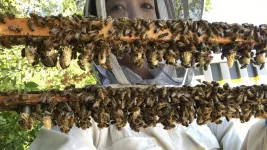(Press-News.org) Honey bee health has been on the decline for two decades, with U.S. and Canadian beekeepers now losing about 25 to 40% of their colonies annually. And queen bees are failing faster than they have in the past in their ability to reproduce. The reason has been a mystery, but researchers at North Carolina State University and the University of British Columbia are finding answers.
Their latest research, published Jan. 8 in the journal Communications Biology, offers clues about what's behind queen bee failure, finding that when sperm viability is low, the expression of a protein known to act against pathogens such as bacteria and viruses is high.
David Tarpy, a University Faculty Scholar and professor in NC State's Department of Entomology and Plant Pathology, says the study has important implications for beekeepers and their customers, the farmers who rely on honey bees to pollinate their crops.
"Beekeepers have identified problem queens as a top management concern, but what's causing the problem is largely invisible. Queens go bad, and we don't know why," Tarpy said.
Alison McAfee, a postdoctoral scientist at NC State and UBC, was the study's lead author. She explained that to have a healthy hive, honey bees depend on a healthy queen, the only female bee in a colony that can reproduce.
The queen mates with many males, but only early in life, storing all the sperm that she'll use in her lifetime in her spermatheca, an abdominal organ that looks like a tiny pearl. When the sperm begin to die, the queen can't produce as many fertilized eggs. That causes the colony's population to decline.
"Queens have the potential to live for five years, but these days, half the time queens (in managed honey bee colonies) are replaced within their first six months because they are failing," McAfee said. "If a beekeeper is really lucky, a queen might live two years. Beekeepers need answers about why their queens are failing.
"The more we can find out about what is actually happening within these failed queens, the closer we can get to understanding why this queen failure is happening in the first place."
In their research, McAfee, Tarpy and their colleagues found that queens that were failing reproductively had significantly fewer sperm than ones that were reproductively thriving. And a higher percentage of the sperm they did have were dead. The researchers also discovered that compared to reproductively healthy queen bees, the failed queens were more likely to have higher levels of two viruses - sacbrood virus and black queen cell virus.
"The high levels of these viruses and poor sperm viability made us interested in seeing if there was a trade-off happening in the honey bee queen," McAfee said. "There's a classical hypothesis in reproductive biology that you can't do everything well, so there's a trade-off between immunity and being able to reproduce. It's been found in quite a few other organisms, including insects, that there are such trade-offs."
To find out if the same would be true with the honeybee queen, the researchers used a tool known as a mass spectrometer to gain a better picture of what was going on in the spermatheca of the healthy and failed queens. They identified 2,000 different proteins and determined which ones were linked to sperm viability.
One of the most significant proteins linked to sperm viability, McAfee said, was lysozyme. Lysozyme is an enzyme that's part of animals' immune systems.
"The queens with the highest sperm viability had the lowest abundance of lysozyme, indicating that they weren't investing resources in this kind of immune response," McAfee added. "That supports this idea that there's a trade-off between the queens being able to fight off infections and being able to maintain their stored sperm."
Tarpy said that the research could begin allowing researchers to find the cause of queen failure and find molecular tools that could "help identify bad queens upstream in the process before beekeepers use them and before they realize they're bad."
Right now, the cause of queen failure isn't clear. "The underlying mechanisms could be disease. They could be pesticides. They could be improper nutrition," he said. "We don't know, so we are working our way backward to identify the causes."
Once the causes are clearly understood, Tarpy added, scientists can then work forward "to help beekeepers keep mortality levels down to sustainable levels and thus keep their colonies thriving."
INFORMATION:
This research was supported by grants from the Natural Sciences and Engineering Research Council of Canada, Genome Canada and Genome British Columbia, Project Apis m, the Boone Hodgson Wilkinson Trust, the Canadian Bee Research Fund and the U.S. Department of Agriculture's National Institute for Agriculture.
An abstract of the paper follows.
"Trade-offs between sperm viability and immune protein expression in honey bee queens (Apis mellifera)"
DOI: 10.1038/s42003-020-01586-w
Authors: Alison McAfee, North Carolina State University and the University of British Columbia; Abigail Chapman and Leonard J. Foster, University of British Columbia; Jeffery S. Pettis, Pettis and Associates; and David R. Tarpy, North Carolina State University
Published: Jan. 8, 2021 in Communications Biology.
Queens of many social hymenoptera keep sperm alive within their specialized storage organ, the spermatheca, for years, defying the typical trade-off between lifespan and reproduction. However, whether honey bee (Apis mellifera) queens experience a trade-off between reproduction and immunity is unknown, and the biochemical processes underlying sperm viability are poorly understood. Here, we survey quality metrics and viral loads of honey bee queens from nine genetic sources. Queens rated as 'failed' by beekeepers had lower sperm viability, fewer sperm, and higher levels of sacbrood virus and black queen cell virus. Quantitative proteomics on N?=?123 spermathecal fluid samples shows, after accounting for sperm count, health status, and apiary effects, five spermathecal fluid proteins significantly correlating with sperm viability: odorant binding protein (OBP)14, lysozyme, serpin 88Ea, artichoke, and heat-shock protein (HSP)10. The significant negative correlation of lysozyme--a conserved immune effector--with sperm viability is consistent with a reproduction vs. immunity trade-off in honey bee queens.
BOSTON -- Completing cancer screening tests, such as mammograms, can be challenging for low-income people, who may face such challenges as lack of transportation or inability to take time off work. A team at Massachusetts General Hospital (MGH) explored the possibility of addressing preventive care needs when patients are admitted to the hospital.
The pilot study, published in the Annals of Family Medicine, examined the feasibility of performing mammograms in women insured by Medicaid or both Medicaid and Medicare (dual-eligible patients) while they were hospitalized. "We designed the study to reach the patients who face significant barriers to completing their mammograms in the outpatient setting," says Andrew S. Hwang, MD, MPH, an internist at MGH and first author of ...
DES PLAINES, IL -- Among children who were not in an independently verified incident, evaluation for child abuse should be done by specialty consultation in children aged less than three-years old presenting with rib fractures and children aged less than 18-months presenting with humeral or femoral fractures. That is the conclusion of a study titled Identifying Maltreatment in Infants and Young Children Presenting with Fractures: Does Age Matter?, to be published in the January 2021 issue of Yersinia pestis (AEM), a journal of the Society for Academic Emergency Medicine (SAEM).
The lead author of the study is Ian ...
Since the dawn of the 21st century, there has been a rapid rise in the number of human immunodeficiency virus (HIV) infections in China, and today, the epidemic continues to grow. Several populations are victims of this virus, including injection drug users, sex workers, and men who have sex with men (MSM). In the various decades since HIV has gripped China, these groups and others have variously been at the forefront or background of national efforts to tackle the epidemic.
In the recent past, the prevalence of HIV has been high among the MSM population, particularly, MSM students. According to China CDC's national data on newly reported ...
(Boston) -- Minimally invasive surgeries in which surgeons gain access to internal tissues through natural orifices or small external excisions are common practice in medicine. They are performed for problems as diverse as delivering stents through catheters, treating abdominal complications, and performing transnasal operations at the skull base in patients with neurological conditions.
The ends of devices for such surgeries are highly flexible (or "articulated") to enable the visualization and specific manipulation of the surgical site in the target tissue. In the case of energy-delivering devices that allow surgeons to cut or dry (desiccate) tissues, and stop internal bleeds (coagulate) deep inside the body, a heat-generating energy source is ...
Earth's ability to absorb nearly a third of human-caused carbon emissions through plants could be halved within the next two decades at the current rate of warming, according to a new study in Science Advances by researchers at Northern Arizona University, the Woodwell Climate Research Center and the University of Waikato, New Zealand. Using more than two decades of data from measurement towers in every major biome across the globe, the team identified a critical temperature tipping point beyond which plants' ability to capture and store atmospheric carbon--a cumulative effect referred to as the "land carbon sink"--decreases as temperatures continue to rise.
The terrestrial biosphere--the activity of land plants and soil microbes--does much of Earth's "breathing," exchanging ...
Researchers from MBARI, the University of Hawai'i at Mānoa (UH Mānoa), and Woods Hole Oceanographic Institution, after years of development and testing, have successfully demonstrated that a fleet of autonomous robots can track and study a moving microbial community in an open-ocean eddy. The results of this research effort were recently published in Science Robotics.
Autonomous robotic fleets enable researchers to observe complex systems in ways that are otherwise impossible with purely ship-based or remote sensing techniques. In a time when the COVID-19 ...
Rising temperatures could trigger Earth's terrestrial ecosystems to transition from carbon sinks to carbon sources in the next 20 to 30 years, according to data from the world's largest continuous carbon monitoring network. The researchers suggest that up to half of land ecosystems could reach this tipping point - when plants begin to release carbon into the atmosphere faster than they sequester it - by 2100 under a business-as-usual emissions scenario. However, biomes that store the most carbon, including rainforests and Taiga forests, may lose more than 45% of their ...
A keen sense of smell is a powerful ability shared by many organisms. However, it has proven difficult to replicate by artificial means. Researchers combined biological and engineered elements to create what is known as a biohybrid component. Their volatile organic compound sensor can effectively detect odors in gaseous form. They hope to refine the concept for use in medical diagnosis and the detection of hazardous materials.
Electronic devices such as cameras, microphones and pressure sensors enable machines to sense and quantify their environments optically, acoustically and physically. Our sense of smell however, despite being one of nature's most primal senses, has proven very difficult ...
Scientists from the Pacific Quantum Center of Far Eastern Federal University (FEFU) figured out how the AFV3-109 protein with slipknot structure folds and unfolds depending on temperature. The protein is typical for the viruses of the oldest single-celled organisms that can survive in the extreme conditions of underwater volcanic sources - archaea. The research outcome appears in PLOS ONE.
Using numerical methods and applying quantum field theory that is unique for the study of proteins, the FEFU scientists have probed into the folding topology (scheme) ...
DURHAM, N.C. - Most of the revenues extracted from use of the world's oceans is concentrated among 100 transnational corporations, which have been identified for the first time by researchers at Duke University and the Stockholm Resilience Centre at Stockholm University.
Dubbed the "Ocean 100," these "ocean economy" companies collectively generated $1.1 trillion in revenues in 2018, according to research published Wednesday in the journal Science Advances. If the group were a country, it would have the world's 16th-largest economy, roughly equivalent to the gross domestic product (GDP) of Mexico.
"Now that we know who some of the biggest beneficiaries from the ocean economy are, this can help improve transparency relating to sustainability and ocean ...





